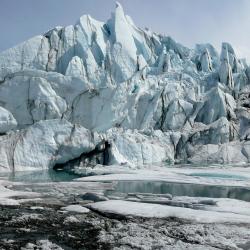What is a Glacier?
Glaciers are fused snow flakes and crystalized ice that form into huge masses. As snow falls, it compacts and deforms under its own weight. This "plastic" ice will move as a response to gravity.
Just like pancake batter spreads on a skillet, so too does the snow and ice as it accumulates in one spot. As snow piles up at the ice cap and transforms into ice, it will eventually spread out until constrained by topography.
Glaciers at Work
Glaciers move under their own weight in response to gravity. In the process, they erode, transport, and deposit rocks and other sediments.
Snow accumulates, compresses, and glaciers form. Erosion occurs as the glacier crushes, grinds, and plucks up rocks and sediment. Boulders and sediment of all sizes, is transported by ice. Meltwater flowing in tunnels under the glacier sorts and moves sediments.
Till forms as unsorted sediments accumulate under the glacier as it moves over the landscape. Outwash deposits accumulate as meltwater dumps coarse materials in front of the glacier. Meltwater then transports fine grained silt and clay to distant lakes basins.

Glacial and Biological Specimens Recovered near Great Gully Gorge, NY
Spruce Log
Great Gully Gorge
~50,000 years old
This log was recovered from the same exposure to the buried peat showing that a spruce forest was growing on the surface during an interglacial period around approximately 50,000 years ago. This sample and other fragments of wood (31,000 years old) buried between glacial till deposits provides the strong scientific evidence of multiple glacial cycles in New York. Previously, it was presumed that the most recent glacial advance destroyed all evidence of past glaciations. This log and peat was too old to radiocarbon date, so scientists used Optically Stimulated Luminescence (OSL) to date the sediment above and below to determine the approximate age.
Glacial Cycles
Glaciers have advanced and retreated across New York many times. Glacial till, the unsorted sediments directly deposited by a glacier, occur as an abundant surface deposit on the landscape. It was generally believed that with each new cycle, the glacier erased the evidence of previous glacial cycles.
However, Museum scientists recently found evidence of at least six glacial cycles at the Great Gully Gorge, near Union Springs, NY, on the eastern shore of Cayuga Lake. By studying and dating the stacked sedimentary units along with collecting drill cores scientist are able to construct a timeline of geological events in the Finger Lakes.

Optically Stimulated Luminescence (OSL)
Where Radiocarbon Dating requires organic material to provide ages and dates, Optically Stimulated Luminescence (OSL) dating does not. OSL is able to use sand-sized pieces of the mineral quartz to estimate when sand grains were buried or last exposed to sunlight. This method is useful to date geologic sediments transported by air (sand dunes) or water (stream and lake deposits), or archaeologic ceramics from 200 years old to 300,000 years old. Museum scientists used OSL to date the sand layers from which the buried peat and spruce log were recovered. This provides dated evidence of at least six glacial cycles.




